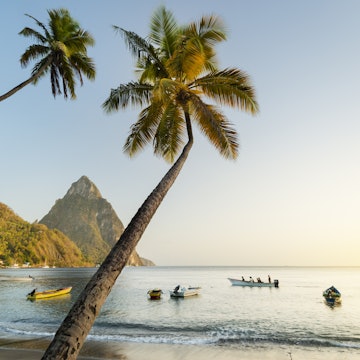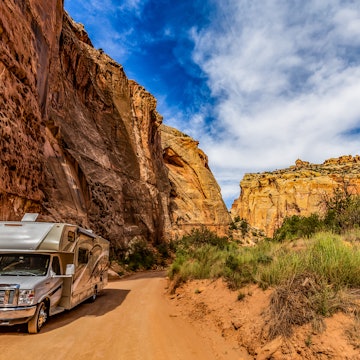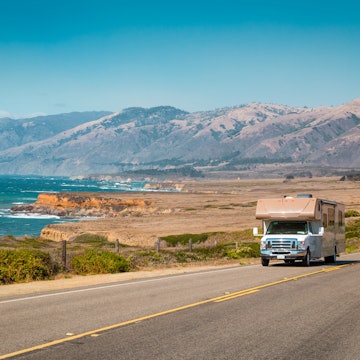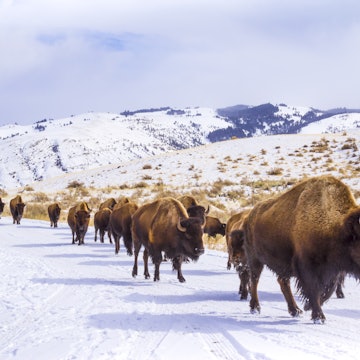
Yosemite vs Yellowstone: which national park is best for you?

Jan 24, 2022 • 7 min read

Both parks are wildly popular with visitors in search of wild beauty, but there are significant differences between the two © Thomas Barwick / Getty Images
Yellowstone National Park is all about spotting bears and bison between hot springs and geysers, in a vast natural setting spanning three states. Yosemite National Park beckons you to chase waterfalls, climb granite domes and hike some of the world’s most beautiful mountain terrain.
Both parks are Unesco World Heritage sites, and both are wildly popular, attracting millions of visitors a year. There are also significant differences between the parks that can make one better than the other, depending on what you’re looking for. Read on to see which we prefer.
Which is better for beauty and wildlife?
Yellowstone and Yosemite all but mean natural beauty and wildlife, but each has specific strengths in those departments.

Yellowstone is full of incredible wildlife
Teeming with moose, elk, bison, grizzly bears, bighorn sheep and wolves, America’s first national park also contains some of the country’s wildest lands, just begging to be explored.
Why winter is the perfect time to spot Yellowstone's wildlife
Yellowstone is home to more than 60% of the world’s geysers – natural hot springs with unique plumbing that causes them to periodically erupt in towering explosions of boiling water and steam. And while these astounding phenomena and their neighboring Technicolor hot springs and bubbling mud pots draw in the crowds (more than 4 million people each year), the surrounding canyons, mountains and forests are no less impressive.

Yosemite's landscapes are picture perfect
Lift your eyes above the crowds, and you’ll feel your heart instantly moved by the unrivaled splendors of Yosemite: the haughty profile of Half Dome, the hulking presence of El Capitan and the gemstone lakes of the high country’s subalpine wilderness.
The park’s waterfalls mesmerize even the most jaded traveler, especially when the spring runoff turns them into spectacularly thunderous cataracts with drenching mists. Yosemite Falls is among the tallest waterfalls in North America, dropping 2425ft in three tiers, and because this gorgeous cascade faces open meadows, you’ll be able to see it from vantage points throughout the valley.
With granite peaks stretching out into the distance, Glacier Point offers one of the most commanding views in California, including a bird’s-eye view of El Capitan and Half Dome – one of many such vistas within the park's borders.
The winner: We’re going to weasel out of one answer here with a split decision: Yosemite wins for natural splendor, and Yellowstone wins for wildlife. (Note: Yellowstone has its own namesake species of weasel, while both parks are home to the long-tailed weasel, among other weasel permutations.)
Do Yosemite or Yellowstone have good hiking and activities?
These are not places to sit back in the Buick and wait for a bear to saunter by looking for a handout. Yellowstone and Yosemite reward anyone ready to actively tackle their stupendous natural attributes.

Spot geysers while exploring Yellowstone
The roads meandering through the park pass numerous trailheads offering a range of walks and hikes, some quite strenuous. Back-country explorations are limited only by your own abilities.
Bunsen Peak (8564ft) is a popular early-season half-day hike that leaves visitors spoilt for choice when it comes to views. Hardy souls who'd prefer to explore further can extend this to a full-day hike by continuing down the mountain’s gentler eastern slope to the Bunsen Peak Rd, then far down (800ft) to the base of seldom-visited Osprey Falls.
The paved and scenic Lone Star Geyser Trail is an undemanding walk (or bike ride if your legs need a rest) along a former service road to one of the park’s largest backcountry geysers. Isolated Lone Star erupts every three hours for two to 30 minutes and reaches 30ft to 45ft in height.
Gravity may be working against you during this uphill two-hour hike on Mt Washburn, but all the effort will be worth it when you stop to enjoy the 360-degree views over the park. It’s Yellowstone’s most popular hike (6.4 miles round-trip). Alternatively, tackle the climb on a mountain bike via a dirt trail.

Yosemite spoils hikers with its choice of trails
Anyone who sat slack-jawed through Free Solo, the gripping account of Alex Honnold’s attempts to make the first solo free climb of El Capitan will have some idea of the pulse-pounding adventures possible in Yosemite.
More than 800 miles of hiking trails spoil you for choice. Easy valley-floor routes can get jammed – escape the teeming masses by heading up. Other diversions include rock climbing, cycling, trail rides, swimming, rafting and cross-country skiing. Climbers come from around the world to grapple with the legendary north face of Half Dome, but good hikers can reach its summit via a 17-mile round-trip trail from Yosemite Valley. The trail gains 4900ft in elevation.
Overnight backpacking trips, especially in the serene alpine meadows of the high country are popular with adventurous hikers. Some sights are served by a variety of trails, each catering to different abilities.
The winner: The opportunities for wilderness adventure in Yellowstone are many, but Yosemite has it all, from gentle trails along the floor of the valley to spine-tingling ascents of its rock faces. Plus, Yosemite remains open to many activities through the winter, while Yellowstone goes into bear-like hibernation.
Which is the best national park for families and couples?
With their beauty and wildlife, Yellowstone and Yosemite may seem like they appeal to everyone, and it's true – both parks have accessible trails and other facilities designed for visitors of all abilities. But each also has its strengths, which cater to different types of travelers.
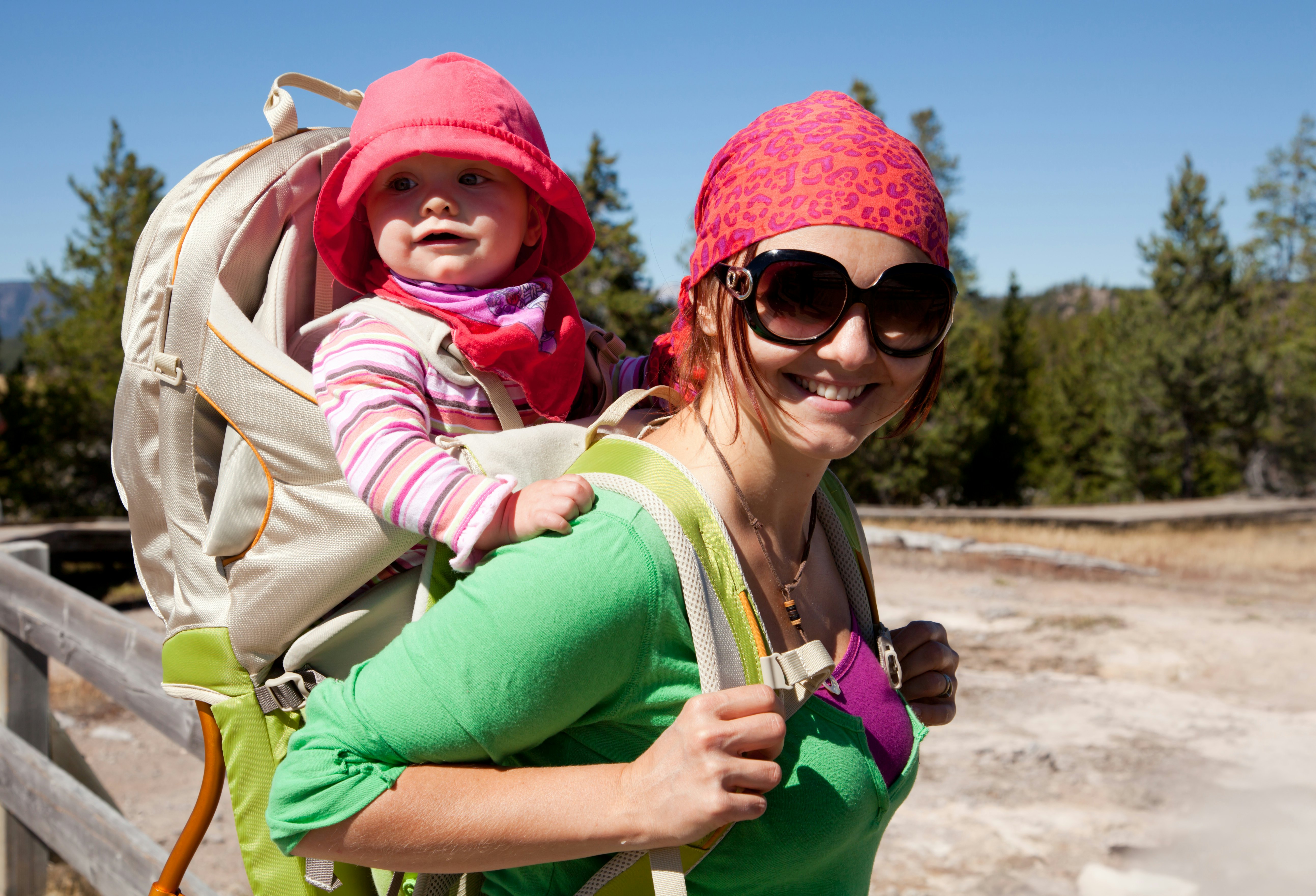
Yellowstone is great for families
There may not be any lions and tigers, but there are plenty of bears – oh my! Despite the need to keep 100 yards away from any grizzly, there’s no doubt that kids of all ages love spotting them. That and all the other wildlife viewing opportunities make Yellowstone a family favorite. Other hits with the gang in the backseat include the many geysers, which might as well be called aquatic fireworks. Short loop trails are ideal places to clear out of the vehicle and romp through the park’s natural beauty.
Yosemite is perfect for solo contemplation
Yes, Yosemite has bears and other wildlife on view, but the real beauty of the park is tied to the contemplation of its spectacular natural beauty. Quietly sitting and watching the play of light on Half Dome is not for all ages; neither are some of the more popular back-country hikes and über-active pursuits, such as rock climbing. While kids certainly enjoy Yosemite, it most rewards those ready to savor it on its own terms.
The winner: We’re going with Yellowstone as the best all-things-for-all-visitors park. Couples looking to snuggle up in one of the historic lodges, adventurers off to tackle the remotest recesses of the outback and teenagers intent on shooting the best selfie right as Old Faithful spurts will all be delighted here.
Can I see Yellowstone or Yosemite on a budget?
Hard-to-secure campground reservations, expensive supplies, costly gas and car rentals – visiting America’s two most famous national parks is certainly not cheap. But there are ways to save, and one park is definitely better for the budget-conscious.
You'll need to bring your car to Yellowstone
Visitors to Yellowstone who aren't on road trips fly into small airports in Jackson, Wyoming, and Bozeman or Billings, Montana – none of which are known for their low fares. You will need a vehicle; there is no public transportation to or within the park.
Plentiful accommodations can be found in the Wyoming and Montana gateway towns of Cody, Gardiner and West Yellowstone. Each has numerous campgrounds and motels at all price points. Inside the park, the campgrounds (most $29–34) and pricey lodges book up far ahead of summer.

Yosemite is reachable from major cities
Yosemite is a reasonable drive from San Francisco (3-1/2 hours) and Los Angeles (5 hours). You can find a cheap flight to any of California’s main airports and then rent a car to get to the park, but it's also one of the few national parks that can easily be reached by public transportation, particularly from the Bay Area. Greyhound buses and Amtrak trains serve Merced, west of the park, where you can transfer to buses to Yosemite, while inside the park, shuttles provide access to many of the key sites. Cycling is an ideal way to take in Yosemite Valley.
Campsites within the park cost $20 to $36 but are almost impossible to reserve due to immense demand. Yosemite’s lodges are pricey and often full. However, towns just outside the park such as Fish Camp, El Portal, Mariposa and Groveland have campgrounds, motels and other lodging at every price point, although quality and salubriousness varies greatly.
The winner: Getting to Yellowstone is expensive: you’ll either be driving from far away and buying a lot of gas, or you’ll be flying with a pricey ticket to a nearby airport and renting a costly vehicle. In contrast, Yosemite is comparatively close to major California cities, and there’s the option of a completely car-free visit. Given that admission, food and lodging costs for the two parks are similar, Yosemite is our budget-friendly choice.










